Although participating farmers on the Dairylink Ireland programme operate a range of systems across different conditions, there are many aspects of their farm businesses that they have in common.
Heifer rearing is a key area of focus in Dairylink Ireland and the main principles apply to all programme participants.
Frank Goodman’s experience of a scour outbreak earlier this spring is detailed below and highlights that even units with excellent hygiene, health plans and colostrum feeding protocols can have issues with disease.
There is a strong case for more on-farm testing of colostrum with devices such as refractometers or colostrometers to identify lower-quality colostrum
Good-quality colostrum is generally defined as having immunoglobin (IgG) levels over 50mg/ml. A study by AFBI, which analysed over 1,200 colostrum samples from commercial dairy farms in Northern Ireland, found that 44% of samples were below the threshold.
There is a strong case for more on-farm testing of colostrum with devices such as refractometers or colostrometers to identify lower-quality colostrum and avoid immunity issues in calves. It could be time and money well spent, given that calves that suffer ill health cost more to rear, take longer to reach target liveweights for breeding and produce less milk as cows.
The aim is to achieve steady growth after weaning at a daily liveweight gain of 0.8kg, or around 25kg per month
Dairylink farmers are also encouraged to monitor growth rates throughout the rearing process by weighing heifers periodically. For farmers without access to weight scales, a lower-cost option is a weigh band, which is fairly accurate at matching shoulder widths to liveweights. This allows heifers to be grouped and fed accordingly to ensure targets are hit.

Weaned calves are getting concentrates at 1kg/calf/day at present.
The aim is to achieve steady growth after weaning at a daily liveweight gain of 0.8kg, or around 25kg per month. The main target is to reach 60% of mature liveweights, which is generally 360kg to 390kg for breeding at 14 to 15 months of age and calving by 24 months.
Weekly round-up
Heifer rearing is important for all Dairylink farms, regardless of system type.Three Qs of giving calves colostrum: quantity, quality and quickness.Despite heavy rain, ground conditions are holding up well on Dairylink farms.Heifers are being weighed periodically to monitor growth rates.Farmer focus: Frank Goodman, Carrickmacross, Co Monaghan
Breeding in the main spring-calving group is ongoing on Frank Goodman’s farm near Carrickmacross. Cows have had seven weeks of AI, with tail paint used as a heat detection aid. Frank is now considering introducing a beef bull shortly to sweep up the milking herd.
There are 20 heifers on an outfarm that were inseminated with sexed semen for six weeks and are now running with a Friesian bull. All heifers were served over the six-week period, with heats also detected by visual observation and tail paint. Heifers were weighed at the start of May and averaged 355kg, which was just slightly short of Frank’s target breeding weight of 360kg.
The main aim with sire selection on the Goodman farm is to lift butterfat and protein levels and improve herd fertility.
Although there have been some heavy downpours over the past few weeks, Frank has been able to keep cows at grass and ground conditions have held up well
Across all sires selected for the 2019 spring breeding season on the Goodman farm, average EBI stands at €290, fertility sub index is €124 and combined butterfat and protein is 30kg.
Although there have been some heavy downpours over the past few weeks, Frank has been able to keep cows at grass and ground conditions have held up well. Covers that had got too heavy for grazing were cut for bales last week and should be ready for grazing in around 10 days’ time.
Some buffer feeding with maize and grass silage was needed for a few days when paddocks with heavy covers were out for silage. Buffer feeding has stopped over the past few days and cows are on a 17-day grazing round at present.
Calves
There are 15 spring-born calves that are still on milk replacer at five litres/calf/day with added natural yoghurt. These calves are in a small paddock beside the calf shed, have access to ad-lib concentrates and will be weaned within two weeks.
Frank had issues with calf scour this spring, although he managed to avoid any mortalities and all calves have recovered and performed well since
The rest of the spring-born calves that are already weaned are on an outfarm and are getting concentrates at 1kg/calf/day at present.
Frank had issues with calf scour this spring, although he managed to avoid any mortalities and all calves have recovered and performed well since. The issue arose at the end of January when incidences of rotavirus started occurring in the calf shed.
This happened even though hygiene and biosecurity were well managed on the Goodman farm. Frank had kept calf-rearing facilities clean and had foot dip at the door of the shed. Calves were also getting plenty of colostrum, with two to four litres given within the first hour.
All calves were treated for coccidiosis at 21 and 65 days of age
Blood samples showed that IgG levels were low in around half the calves that were sampled. Frank vaccinated calves for rotavirus and adjusted crude protein levels in the dry cow ration by increasing soya levels by 750g/cow/day, which resolved the issue.
All calves were treated for coccidiosis at 21 and 65 days of age. Additional measures at three weeks of age include disbudding and vaccination for IBR.
Calves were treated with a broad spectrum anthelmintic at three weeks after turnout. Follow-up treatments are planned for during the summer in the calf group and maiden heifers also received an anthelmintic treatment at the end of May.
Although participating farmers on the Dairylink Ireland programme operate a range of systems across different conditions, there are many aspects of their farm businesses that they have in common.
Heifer rearing is a key area of focus in Dairylink Ireland and the main principles apply to all programme participants.
Frank Goodman’s experience of a scour outbreak earlier this spring is detailed below and highlights that even units with excellent hygiene, health plans and colostrum feeding protocols can have issues with disease.
There is a strong case for more on-farm testing of colostrum with devices such as refractometers or colostrometers to identify lower-quality colostrum
Good-quality colostrum is generally defined as having immunoglobin (IgG) levels over 50mg/ml. A study by AFBI, which analysed over 1,200 colostrum samples from commercial dairy farms in Northern Ireland, found that 44% of samples were below the threshold.
There is a strong case for more on-farm testing of colostrum with devices such as refractometers or colostrometers to identify lower-quality colostrum and avoid immunity issues in calves. It could be time and money well spent, given that calves that suffer ill health cost more to rear, take longer to reach target liveweights for breeding and produce less milk as cows.
The aim is to achieve steady growth after weaning at a daily liveweight gain of 0.8kg, or around 25kg per month
Dairylink farmers are also encouraged to monitor growth rates throughout the rearing process by weighing heifers periodically. For farmers without access to weight scales, a lower-cost option is a weigh band, which is fairly accurate at matching shoulder widths to liveweights. This allows heifers to be grouped and fed accordingly to ensure targets are hit.

Weaned calves are getting concentrates at 1kg/calf/day at present.
The aim is to achieve steady growth after weaning at a daily liveweight gain of 0.8kg, or around 25kg per month. The main target is to reach 60% of mature liveweights, which is generally 360kg to 390kg for breeding at 14 to 15 months of age and calving by 24 months.
Weekly round-up
Heifer rearing is important for all Dairylink farms, regardless of system type.Three Qs of giving calves colostrum: quantity, quality and quickness.Despite heavy rain, ground conditions are holding up well on Dairylink farms.Heifers are being weighed periodically to monitor growth rates.Farmer focus: Frank Goodman, Carrickmacross, Co Monaghan
Breeding in the main spring-calving group is ongoing on Frank Goodman’s farm near Carrickmacross. Cows have had seven weeks of AI, with tail paint used as a heat detection aid. Frank is now considering introducing a beef bull shortly to sweep up the milking herd.
There are 20 heifers on an outfarm that were inseminated with sexed semen for six weeks and are now running with a Friesian bull. All heifers were served over the six-week period, with heats also detected by visual observation and tail paint. Heifers were weighed at the start of May and averaged 355kg, which was just slightly short of Frank’s target breeding weight of 360kg.
The main aim with sire selection on the Goodman farm is to lift butterfat and protein levels and improve herd fertility.
Although there have been some heavy downpours over the past few weeks, Frank has been able to keep cows at grass and ground conditions have held up well
Across all sires selected for the 2019 spring breeding season on the Goodman farm, average EBI stands at €290, fertility sub index is €124 and combined butterfat and protein is 30kg.
Although there have been some heavy downpours over the past few weeks, Frank has been able to keep cows at grass and ground conditions have held up well. Covers that had got too heavy for grazing were cut for bales last week and should be ready for grazing in around 10 days’ time.
Some buffer feeding with maize and grass silage was needed for a few days when paddocks with heavy covers were out for silage. Buffer feeding has stopped over the past few days and cows are on a 17-day grazing round at present.
Calves
There are 15 spring-born calves that are still on milk replacer at five litres/calf/day with added natural yoghurt. These calves are in a small paddock beside the calf shed, have access to ad-lib concentrates and will be weaned within two weeks.
Frank had issues with calf scour this spring, although he managed to avoid any mortalities and all calves have recovered and performed well since
The rest of the spring-born calves that are already weaned are on an outfarm and are getting concentrates at 1kg/calf/day at present.
Frank had issues with calf scour this spring, although he managed to avoid any mortalities and all calves have recovered and performed well since. The issue arose at the end of January when incidences of rotavirus started occurring in the calf shed.
This happened even though hygiene and biosecurity were well managed on the Goodman farm. Frank had kept calf-rearing facilities clean and had foot dip at the door of the shed. Calves were also getting plenty of colostrum, with two to four litres given within the first hour.
All calves were treated for coccidiosis at 21 and 65 days of age
Blood samples showed that IgG levels were low in around half the calves that were sampled. Frank vaccinated calves for rotavirus and adjusted crude protein levels in the dry cow ration by increasing soya levels by 750g/cow/day, which resolved the issue.
All calves were treated for coccidiosis at 21 and 65 days of age. Additional measures at three weeks of age include disbudding and vaccination for IBR.
Calves were treated with a broad spectrum anthelmintic at three weeks after turnout. Follow-up treatments are planned for during the summer in the calf group and maiden heifers also received an anthelmintic treatment at the end of May.







 This is a subscriber-only article
This is a subscriber-only article










SHARING OPTIONS: